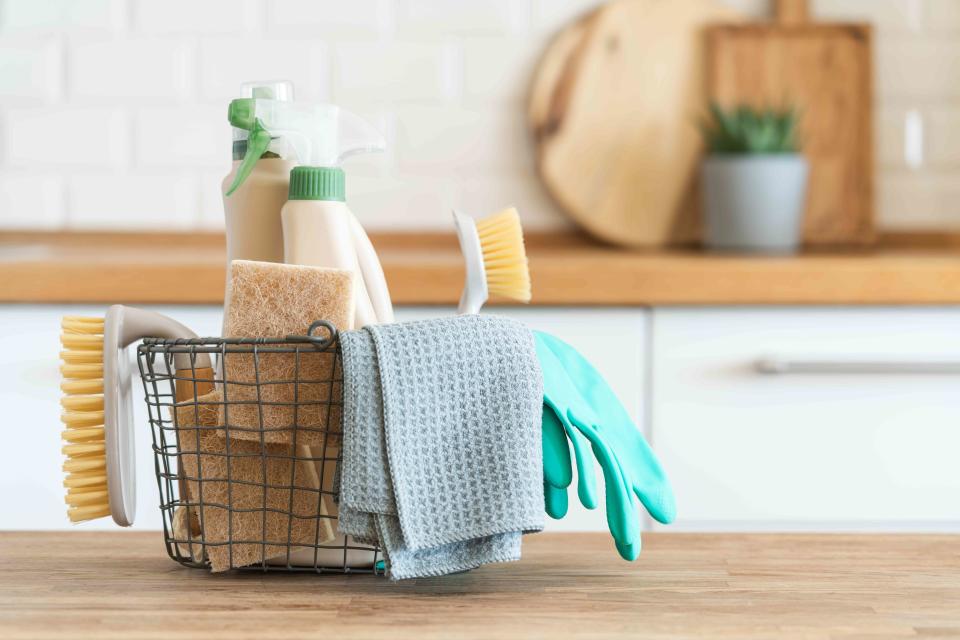The One Thing You’re Forgetting To Sanitize That’s Sabotaging Your Cleaning Game
Is it all for nothing?

Anna Puzatykh/Getty Images
There’s nothing worse that putting in hours of scrubbing (or maybe just minutes that feel like hours) only to realize you’ve essentially been sabotaging yourself. How could one possibly do that, you ask? The answer is simple: by not keeping your cleaning tools clean.
If you haven’t given much thought to actually cleaning your scrub brushes, attachments, and more, you’re not alone. While many of us have our regular cleaning schedules down from tubs to toilets, the not-so-intuitive items that we’re forgetting to clean might just be the ones that are holding our homes back from living up to their true, nearly-germ-free potential. Get these items on your radar ASAP. Your immune system can thank us later.
Toilet Brushes
Toilet brushes and wands should be cleaned after every use. Let that soak in. If you use toilet wands, wipe down the handle with a disinfectant spray or wipe then let it dry before storing.
For a traditional toilet brush, submerge in a solution of equal parts bleach and water. It’s important to note that toilet cleaning solution should never come in contact with bleach as it can produce harmful fumes, so be sure your brush has been thoroughly rinsed before you add it to the bleach solution. Let it sit in the solution for a few minutes, then rinse in hot water and let it dry. Place your brush handle between the base of the toilet and the seat so the brush head hangs over the bowl while it dries.
Scrub Brushes
Yes, even your scrub brushes will need regular cleaning. It’s a safe bet to do this task weekly. Start by removing any dust, hair, or other debris that’s clinging to the bristles. You can choose either one of these solutions to soak the brushes in: equal parts water and vinegar or hot water and a few drops of liquid dish soap. Alternatively, you can also run your brushes in your dishwasher. Let them dry completely before storing.
Vacuum Attachments
Even your vacuum attachments need regular washing. Think about all the times you’ve used the crevice tool to clean around your toilet. Yeah, it made us break out in a cold sweat, too. For attachments with bristles, you can follow the same process as outlined above for scrub brushes. For tools without bristles, wash them in warm, soapy water to remove any dirt and debris, let them dry, then spray them with a disinfectant spray.
Related: People Who Have The Cleanest Homes Always Vacuum First
Sponges
There are some ground rules when it comes to sponges that can help protect your kitchen from harmful lurking bacteria, for example, not wiping down your counters with your dish sponge, but rather using a separate clean cloth or paper towel. It’s best to swap out your sponge every week or two (or as soon as it has an odor) but, in between, you can either run the sponge through the dishwasher or microwave it (while its wet) for one minute. Just be sure it doesn’t contain metal and also take care to safely remove it as it will be piping hot once it’s finished cooking.
Rags and Microfiber Cloths
Chances are you’re already washing your rags and microfiber cloths after every use, but it’s also important to make sure you don’t cross-contaminate spaces and surfaces by using the same cloth. For example, don’t use the same cloth to wipe down your sink and toilet. Also, don’t bring a towel that you use for one bathroom into another—and certainly don’t go from bathroom to kitchen (shudder). Invest in a box of cloths so that you can grab a fresh one for each new job, cutting down on germ transfer and other contamination concerns.
For more Southern Living news, make sure to sign up for our newsletter!
Read the original article on Southern Living.

